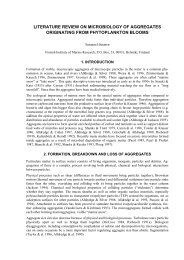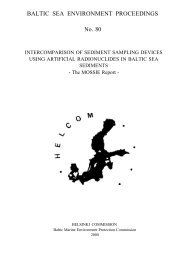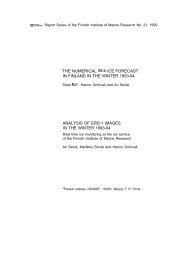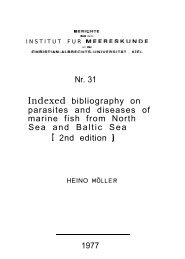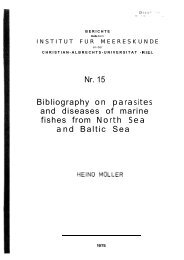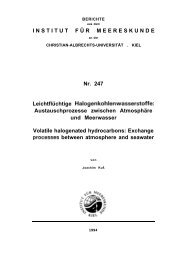marine research in finland - Baltic Marine Environment Bibliography
marine research in finland - Baltic Marine Environment Bibliography
marine research in finland - Baltic Marine Environment Bibliography
Create successful ePaper yourself
Turn your PDF publications into a flip-book with our unique Google optimized e-Paper software.
37<br />
IV EUROPEAN VIEWS<br />
1. CASE STUDY: PHYSICAL OCEANOGRAPHY<br />
H.U. Lass (based on notes by J. F.)<br />
- Physical oceanography concern<strong>in</strong>g not only the <strong>Baltic</strong> Sea but also other parts of the world’s<br />
oceans<br />
- Situation <strong>in</strong> Germany different. There are several <strong>in</strong>stitutes which deal with physical oceanography<br />
over the whole world, especially <strong>in</strong> the Atlantic from Arctic to Antarctic.<br />
- So our <strong>in</strong>stitute (Warnemt<strong>in</strong>de) concentrates on <strong>research</strong> <strong>in</strong> the <strong>Baltic</strong> (adm<strong>in</strong>istrative and f<strong>in</strong>ancial<br />
reasons)<br />
- Important problems and how to study these:<br />
- general properties of the <strong>Baltic</strong> Sea, which control more or less the ma<strong>in</strong> features of this sea:<br />
- In the Belts region precipitation exceeds evaporation, so we have a brackish surface layer, and<br />
a sal<strong>in</strong>e deeper layer. Surface water flows outwards, heavier sal<strong>in</strong>e bottom water flows <strong>in</strong>. This<br />
property makes the <strong>Baltic</strong> a nutrient trap, where nutrients circulate, and very little is exported.<br />
- L<strong>in</strong>ks to the open sea are long and shallow. Because of the length and shallowness of the channels,<br />
sea level differences between the North Sea and the <strong>Baltic</strong> are the ma<strong>in</strong> driv<strong>in</strong>g force <strong>in</strong><br />
water exchange. This is caused by a barocl<strong>in</strong>ic pressure gradient. Due to the sal<strong>in</strong>ity differences<br />
between the North Sea and the <strong>Baltic</strong>, which is of very steady nature <strong>in</strong> contrast to sea level differences,<br />
the sal<strong>in</strong>e u’ater forc<strong>in</strong>g jwm the North Sea to the <strong>Baltic</strong> is of a transient nature, <strong>in</strong><br />
contrast with the Mediterranean and the Atlantic, where the connect<strong>in</strong>g channel is deep and<br />
short. So we have this rather transient problem <strong>in</strong> <strong>Baltic</strong> physical properties.<br />
- The barotrophically-driven water exchange, which comes through the straits, forces the ma<strong>in</strong><br />
sea level of the <strong>Baltic</strong> to rise <strong>in</strong> the case of an <strong>in</strong>flow, and this feeds back on the driv<strong>in</strong>g pressure<br />
gradient, and the <strong>Baltic</strong> fills up, caus<strong>in</strong>g an end to <strong>in</strong>flow. So the <strong>in</strong>flows are thus only transient<br />
ones, last<strong>in</strong>g some ten days maximum.<br />
- The length of the connect<strong>in</strong>g channels causes the <strong>in</strong>flow<strong>in</strong>g sal<strong>in</strong>e water to flow back and forth<br />
<strong>in</strong> the channels, and the sal<strong>in</strong>ity fronts very rarely approaches the Dars sill and enters the <strong>Baltic</strong><br />
bas<strong>in</strong>s.<br />
- Occasionally, when sal<strong>in</strong>e water enters the bas<strong>in</strong>s <strong>in</strong> the <strong>Baltic</strong>, it causes ventilation and establishes<br />
the stratification.<br />
- We have a variety of processes <strong>in</strong> the <strong>Baltic</strong> to study. The most important is the water exchange:<br />
the forc<strong>in</strong>g of sal<strong>in</strong>e water and the transition of water masses <strong>in</strong> the Belt sea. If the water<br />
from the Skagerrak enters the Belt sea and is moved through the Sea straits, then its properties<br />
are quite different when it enters the <strong>Baltic</strong>, <strong>in</strong> contrast to the water masses that enter the great<br />
Belt.<br />
- Propagation of the salt water <strong>in</strong> the <strong>Baltic</strong> bas<strong>in</strong>s and the effectiveness of the deep water ventilation.<br />
- Propagation velocity, horizontal and vertical structure; what is the role of friction <strong>in</strong> these<br />
processes?<br />
- which are the physical processes controll<strong>in</strong>g these phenomena? Friction?<br />
- Pathways, and the transformation of the properties of propagat<strong>in</strong>g salt water?<br />
- Pathways of <strong>in</strong>com<strong>in</strong>g sal<strong>in</strong>e waters through places of heavy vertical deposition of organic<br />
materials, and transformation of the sal<strong>in</strong>e water by organic load<strong>in</strong>g caused by this deposition.<br />
This causes high oxygen consumption rates <strong>in</strong> deep bas<strong>in</strong>s when the water arrives there.




